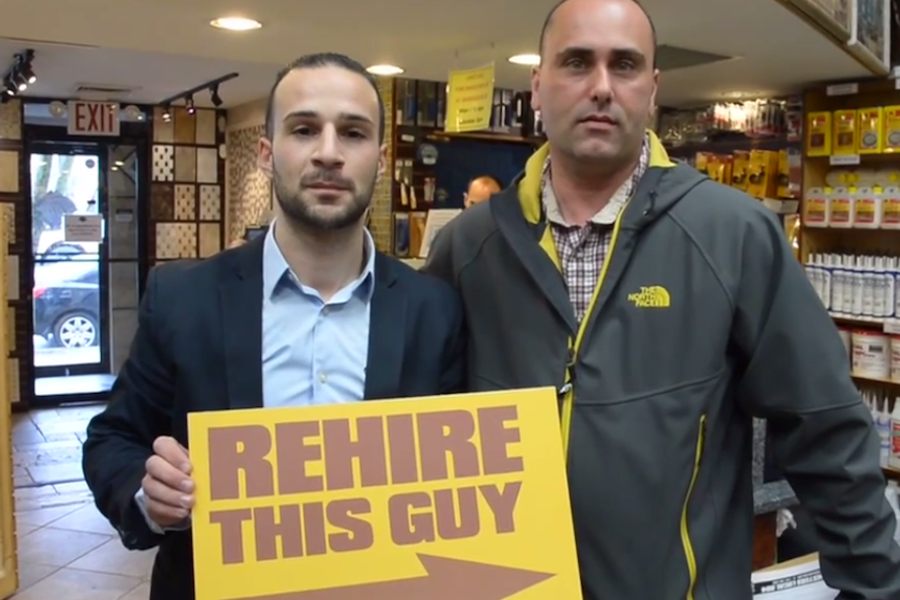
Two hundred and fifty UPS drivers, clad in their brown uniforms, rallying in a Queens parking lot, must have been quite a sight. Not very many people got to see it, however. The 90-minute work stoppage outside the Maspeth, Queens, UPS facility on February 26 was a spontaneous protest against the firing, allegedly without due process, of one of their colleagues, Jairo Reyes.
On March 26, UPS retaliated by beginning to give all 250 notices that they’d be terminated — but the company did not fire the workers all at once. According to the Teamsters, UPS fired 20 drivers on March 31 and kept the rest waiting for the axe to fall while their replacements were trained.
Nearly two months later, all 250, including Reyes, will be headed back to work, their terminations reduced to ten-day suspensions. Driver Steven Curcio, who says he was one of the first to be fired, credits the support of the community, elected officials and particularly his own customers.
Tim Sylvester, president of Teamsters Local 804, the union that represents the Queens drivers, said, “The drivers delivered their message to UPS about unfair treatment. Now every one of them will be back delivering packages.”
The saga began on Valentine’s Day, when Reyes was told he was fired for clocking in early. His delivery route takes him to a mall in Queens, and he’d been regularly clocking in early — with permission, he says — to get there in time to park at one of the few delivery bays and drop his packages
Under Local 804’s contract with UPS, drivers have an “innocent until proven guilty” clause stipulating that they can’t be taken off the job until they have a hearing, but Reyes was escorted off the job on the 14th. When he finally received a hearing on February 26, according to the union, he was officially fired for dishonesty.
Curcio says that after the hearing, the union representative in attendance came through the building and gathered the workers outside to explain to them what had happened. That briefing became a rally and work stoppage — a wildcat action that kept the drivers in the parking lot for about 90 minutes before returning to deliver their packages.
Though their contract also stipulates that the drivers have a right to strike if the company does not “abide by the procedure prescribed for the settlement of disputes and differences,” UPS issued termination notices to all 250 drivers. A spokesperson for the company said that they were being let go because of the “seriousness of [their] misconduct.”
The drivers continued to work for weeks, according to Curcio, amidst rumors and speculation — no one seemed to know for sure when the axe would fall. Then one night at the end of their shift, he says, “all of the higher ups of UPS” showed up. Then, he says, management chose 20 drivers, seemingly at random, to fire that day. Curcio was one of them.
“Whether you’d worked there one year or 30 years, we were all considered in that same boat,” says the 19-year UPS veteran. “My first thought was, ‘How are we going to fix this problem?’ ”
The union had been organizing to bring UPS to the table from the date of the first incident. Local 804 began with internal mobilization, activating networks of union members that had recently been used for contract negotiations to circulate information and a petition of support for the fired drivers. Then they reached out to the Working Families Party, of which the Teamsters’ regional body is a member, and the WFP put out a petition to the public on MoveOn.org’s petition site asking for the drivers to be reinstated. The petitions circulated by drivers and the WFP had a total of more than 100,000 signatures when they were delivered to UPS at a rally on March 21 at the UPS facility in Queens, led by Public Advocate Letitia James, a longtime Working Families Party ally.
“Hundreds of thousands of supporters rushed to the defense of the 250 workers and their families with petition signatures, social media actions, and phone calls that we were proud to help the Teamsters organize,” says the WFP’s Bill Lipton.
James didn’t just show up at a rally or two. She promised that if UPS didn’t come to the table and negotiate with the workers, the company’s tax breaks, business with the city, and even a “sweetheart parking-ticket program” that lets the company pay a fraction of the price of its parking tickets might be up for scrutiny. Comptroller Scott Stringer also spoke up for the workers, as did many members of the City Council, at a second rally and press conference at City Hall April 3, after the twenty workers were fired. Other unions came out in support as well: Transport Workers Union Local 100 and SEIU 32BJ joined the rally.
UPS responded to the rally by firing another 17 random workers the next day.
The tide turned, though, when Curcio and other fired drivers began to visit their former customers to explain the situation and ask for their support, challenging the company’s line that “we owe it to our customers” to fire the drivers.
“Some of the businesses that we deliver to, I’ve personally delivered to them for 13 years,” he says. “Some may say ‘You know my facilities better than I do.’ I know that girl in their office is on vacation or that gentleman isn’t going to be there but his cousin may live down the block. I know where to bring my stuff, I know where to go, where not to go. I know these people, I see them, especially businesses, I see them four to five times a week.”
Curcio was heartened by the reaction from the customers. They wanted to know why he’d been fired, and were happy to show their support for him and his union. He and other drivers took photos and shot a video of their customers calling for their drivers back.
The outpouring of support from customers seemed to take away the last angle UPS had to defend its crackdown on the workers. The company came to the table to negotiate with the union and agreed to a deal that would reinstate all the drivers — including Reyes — and change their terminations to ten-day suspensions. Curcio had already served most of that time; others will take their suspensions on a rolling basis.
The workers are calling this a win, and it’s worth noting that it’s a win that came through the willingness of 250 people to risk their own jobs to stand up to the boss and to save the job of one of their colleagues. But the wildcat action had to be backed up with organizing both inside the union and within the community (and sympathetic elected officials who owe their positions to union support certainly didn’t hurt, either). It can require quite a lot of pressure to bring a massive company like UPS to the table, but the workers succeeded. The WFP’s Lipton says, “When workers stand together in solidarity they can still win against one of the biggest corporations in America.”
It’s also worth noting that this was a workplace that already had a union contract with strong protections for workers against summary firings. Just getting the contract is only the first step; enforcing that contract requires attention and action on the part of the workers. Organizing isn’t over when the contract is ratified — in many ways, it is only beginning. The UPS workers remind us that workplace rights have always been won and held through struggle.
Curcio expects treatment will be a little bit better at the Maspeth facility from now on. “I think everyone involved learned something from this,” he says. “Teamwork usually always prevails in whatever it is in life.”
For now, he’s looking forward to getting back to work. “I can’t wait to get back in my little brown truck and do what I normally do on a daily basis. Go see customers, deliver, do my pick ups and basically back to business as usual.”
Sarah Jaffe is a writer and reporter living in New Orleans and on the road. She is the author of Work Won’t Love You Back: How Devotion To Our Jobs Keeps Us Exploited, Exhausted, and Alone; Necessary Trouble: Americans in Revolt, and her latest book is From the Ashes: Grief and Revolution in a World on Fire, all from Bold Type Books. Her journalism covers the politics of power, from the workplace to the streets, and her writing has been published in The Nation, The Washington Post, The Guardian, The New Republic, the New York Review of Books, and many other outlets. She is a columnist at The Progressive and In These Times. She also co-hosts the Belabored podcast, with Michelle Chen, covering today’s labor movement, and Heart Reacts, with Craig Gent, an advice podcast for the collapse of late capitalism. Sarah has been a waitress, a bicycle mechanic, and a social media consultant, cleaned up trash and scooped ice cream and explained Soviet communism to middle schoolers. Journalism pays better than some of these. You can follow her on Twitter @sarahljaffe.








